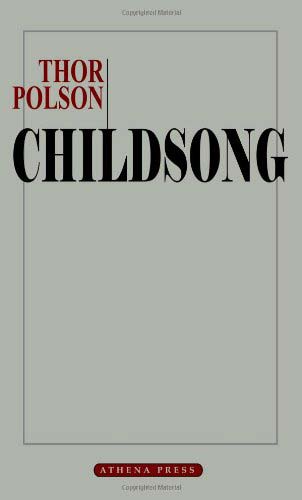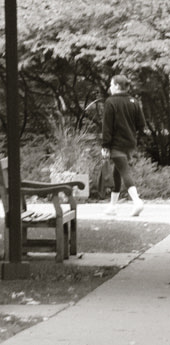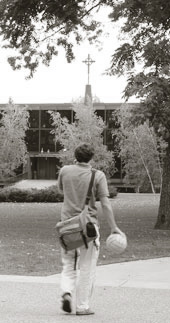CHILDSONG is available through Amazon.
Please click for details.
Excerpt from the Novel
Book Reviews
Author Interviews
Reviews of Childsong
Inside the plain, grey, nondescript cover of Childsong is, in my opinion, a work of literary genius. Sometimes the most difficult book to read can be the most rewarding and, as you read further, becomes more and more interesting.
Examining and putting forward the turbulent environment of college students anywhere and at any time makes any specification of place and time unnecessary, thus the writer does not give an exact location or an exact date. For those that focus on detail this may be hard to overcome [sic], but this dismissal of information lends to the universal relevance of the characters.
I could see myself, as you will be able to see yourself, among the group of self-centered, free-wheeling, fun-loving college students. We are not always proud of who we were during those years of discovery, but every experience you go through makes you stronger. With characters that are not all good or all bad, we read of a group that is loveable and dislikeable all in one. Sometimes, and definitely in this case, extraordinary things transpire in the most ordinary of circumstances.
With Childsong, Thor Polson uses his talent with words to create a piece of work that was definitely worth the twenty-year wait. This is not meant to be an easy read, but once you become engrossed in the story, and you will, you will not put this book down. When you are reading the final sentence (“They sat silently in the park and listened to the wind in the trees.”), you will realize that life is what you make of it.
— Danelle Drake, Reader Views
Is the current generation of youngsters set for self-destruction? Childsong is the tale of a group of friends hailing from a small college in the Midwestern United States where they face the terrifying truth of adulthood, where they must learn to survive and cope with the most terrifying lesson they will learn of all — that the world is not all about them. Childsong is a well-written coming-of-age novel with a deft criticism of the current generation, a top pick for any community-library fiction collections.
— Midwest Book Review
Childsong tells the stories of some freshmen in a Midwest Christian liberal-arts college. Despite the great expectations from parents and family, these young men and women soon find college life boring and empty. Lost and self-centered, they begin to squander their freedom with youthful excesses. Some try to fight off their boredom with overdrinking and frivolous romances. Others turn to even more dangerous outlets. Though bearing symptoms of the Me-Generation such as jealousy, hypocrisy, selfishness and apathy, these young men and women are also searching, no matter how erratically, for something that they can put their hope and faith into. At the end of the novella, the protagonist, Tommy Pendoro, finds his peace in poetry. Others are not so lucky. Childsong is experimental in that this novella is a combination of poetry, playwriting, monologue and narrative. For readers who love the art of words and who can relate to the disappointments and struggles of adolescence and early childhood [sic], it is a gem.
— Sophia Geng, Minnesota Literature
Thor Polson wrote this exploration of youth in the early 1980s and waited twenty years to publish it. The story revolves around a group of students at a small college in the Midwest U.S. and details how their selfishness, jealousy and despair affect their thoughts and actions.
The book begins with Clifton, the egotistical jock who thinks he has the world at his beck and call. This is the young man whom all the girls and boys love. He’s self-centered and thinks that the world revolves around him. He’s also rude and self-serving, yet that doesn’t stop others from looking up to him and coveting what he has.
The other main character seems to be Thomas, a student who has the potential to do great things, but circumstances have gotten in his way. He wants to be a poet yet never seems to finish anything he starts; if he does finish something, he ends up burning it. He’s afraid to share his work with others for fear of rejection, and the few poems others have read are difficult for them to understand. The Me-Generation mentality of the 1980s prevents his peers from seeing past their own ideas and ideals and grasp what Thomas feels.
Other students include a girl every boy wants to love, another girl who is actually worthy of every boy’s love but not pretty enough to draw the attention. There’s a boy struggling with feelings of homosexuality, and a boy who feels cast aside by his peers.
Polson’s writing is unique. Combining narrative, prose and creative writing, he has meshed a conglomeration of techniques into a book that forces the readers to slow down and confront what the cast of characters is facing. It is indeed an interesting style of writing and one I’ve never encountered before.
Although difficult to read at times, Childsong does stir the reader’s emotions. Polson creates a story line that makes you angry, sympathetic, empathetic and sad all at the same time. This is a creative book – to say the least – and one that will require your full attention.
— LuAnn Morgan, Rebecca’s Reads
One of those rare books that will change the way you think. A hard read but well worth it!
— Danelle Drake, Book Reporter: Word of Mouth
In Childsong, Thor Polson might be channeling The Catcher in the Rye and Hesse ‘circa’ Peter Camenzind and Demian. The back cover blurb bills Childsong as a novel of “adolescence and early adulthood” that tells the story of a group of first-year liberal arts college students in the American Midwest. (It also reveals that all but one of the students self-destructs.) Themes of teenage angst, despair, identity, belonging, and loss recall the struggles of Salinger’s Holden Caulfield. The implicit critique of an education that focuses more on technical knowledge and societal fit than personal journey and spiritual development recalls Hesse, as does the concern for com/passion and order.
In his foreword to the novel, Polson describes Childsong as “experimental and kaleidoscopic”— probably meant to signal such textual breaks from conventional narrative as the insertion of graphic elements, script, liturgy, Latin, Old English poetry, philosophy, and song etc., interspersed with colloquial dialogue and shifting voice. Yet there is flow in the presentation and unfolding of the story. The longer first part (96 pages) and shorter middle sections (parts two and three are both 17 pages) come together thematically to a dramatic resolution in part four (25 pages). The experimental actually becomes quite neatly idealistic, if not conventional.
The protagonist, Tommy Pendoro, could be a stand-in for Thor Polson himself. The two share the same initials. And even if this is not quasi-autobiography, Tommy Pendoro—a reader can believe—is the mouthpiece for the author. Through Pendoro, Polson wrangles with challenges and decisive events in first-year college life. The struggles are played through a kind of ‘Greek plot’ in which the hero overcomes lures of hedonism and selfishness to find redemption through poetry. (Other characters don’t fare so well, succumbing to accidental death, suicide, the platitudinous, or dissolution.)
What makes this read appealing (to this reader) is its hopefulness and its elevation of the arts. Childsong raises poetry to the high ground of recovery and self-actualization: one young man, the hero, comes to compassion by way of art, while the egotistical, the mean and the defeated fall away. Childsong also wants to celebrate the joyous and the exuberant—what is authentic and good in the childlike. Both Tommy Pendoro and Thor Polson, I would say, aim to preserve a youthful/childlike goodness and authenticity while surrendering youthful egotism to a compassionate hearkening to the other.
Childsong includes a ‘mini-manifesto’ to the call of Orpheus as well—the legendary Thracian musician/poet of Greek myth who captured life in words and music. Tommy/ Thor will use the deeds of his peers—“both foolish and meritorious” as “grist for his creativity.” He will drink from the “Orphic cup”; “he is an “artist,” a “Creator” with a capital “C,” and will “die content in the knowledge that he had served his calling and had not turned away.” This is the high and heady stuff of commitment to the arts, and I like it.
By way of postscript, however, the artist in this reader would have given the cover a more inviting design—for those who tend to judge a book by its cover. The plain grey does not serve to bring a reader in.
— Elana Wolff, poet and essayist
I really enjoyed Childsong. Thor Polson has an original voice, and the angst channeled through these characters feels very real. It feels like a hidden gem, the kind of book recommended by the smart friend of a smart friend at a stupid party that makes the night worthwhile. It’s the kind of book you wait a year to get to and then feel remorse that you lived the interval without the benefit of its world view.
Childsong slides between Joycean forms, at once inhabiting the nightmarish awe of Portrait of the Artist and the sardonic structural experimentation of Ulysses. There’s also a little of Pynchon here–the modern paranoid energy of V.
Childsong takes murky emotion and crystallizes the actions that surround it in such a way that my own memory of life is somehow clearer, something closer to universal memory. Thor Polson has an original descriptive eye, and the characters in this book see the world with a flawed visionary angst that makes everyday objects shimmer, but coming through the lofty construction is simple, honest dialogue.
— Ben Warner, author
Anyone who has spent at least one year at a residential college or university will recognize not only the characters in this novel but also the moral and personal dilemmas that young adults encounter as they try to forge their own identities. Even if they could work at figuring themselves out in isolation, it would be hard enough sorting through the uplifting moments and, more weighty, the emotional baggage of their upbringing and adolescence. When they are thrown together and must play off each other, the college experience resembles a battlefield of personalities that leaves behind a number of severe casualties, and even those who survive more or less in one piece acquire scars that will endure.
The college is located in the Midwest in what looks like the ’70s or ’80s, though the constellation of characters and their conflicts could arise anywhere. Perhaps the time period is less than universal, with a focus on what the author calls the Me-Generation, but it doesn’t take much effort, mutatis mutandis, to see a common struggle to assert oneself while at the same time to learn how to live among others with a similar inexperience at asserting themselves.
There is no single focalizing character but Tommy Pendoro, with the same initials as the author, is called the protagonist in the foreword. Even if he is not always the most sympathetic figure in the novel, his endeavor to use poetry to sublimate his frustrations and to give expression to his disordered world raises him in our eyes as the most sensitive of the rather self-centered group. Besides Tommy, we get to know with some intimacy, among others, a strict church-going innocent whose piety is confused with his troubled childhood, an athletic ex-sailor whose sexual prowess is not all that it seems, a brilliant beauty whose promiscuity overshadows what she really has to offer, a jealous stud, a number of beer-guzzling hedonists, a couple of sexually wayward professors, and a hypocritical theologian. Their interaction leads to a few moments of unpleasantness that escalate to a few disasters which, while not what we all encounter in college, represent extremes of what the collection of post-adolescents tends to produce.
The remarkable feature of this novel is its style, or rather, its experimentation with style. The narrative follows a labyrinthine and fragmented path rather than taking us from the beginning of the school year to the end in a straightforward manner. Readers must work to piece together the incidents by determining how each section fits the chronological scheme and how it serves to characterize the students from a new point of view. Several stretches clearly do not portray what actually happened but rather offer a bizarre scenario that tell us in a non- representational manner what is essentially at stake with the students. One segment is modeled on the “Circe” episode of Ulysses (with a bow also to “Ithaca”), a dream-play that describes fancifully what this first year of college involves for our cast of characters. Word play is the hallmark of this novel, some very clever and some deliberately sophomoric.
The author is in full command of language throughout, from the dialogue to the poetic descriptions to the poetry itself. While exploring the nature of post- adolescence, he is celebrating the power and joy of the word.
— Scott Richardson, professor of classics




